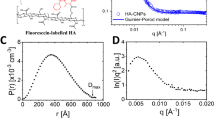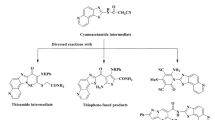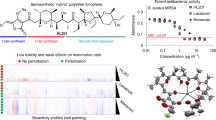Abstract
In the course of our screening for binding inhibitors of CD44 and hyaluronic acid, five active compounds, F-16438 A, B, E, F and G were found and isolated from the cultured broth of a fungal strain, Gloeoporus dichrous SANK 30502. The structures of these compounds except for F-16438 G were elucidated by physico-chemical and spectral data to be new compounds related to caloporoside; F-16438 G was identified to be the 6′-malonylated derivative of caloporoside.
Similar content being viewed by others
Log in or create a free account to read this content
Gain free access to this article, as well as selected content from this journal and more on nature.com
or
References
Abatangelo G, O'Regan M . Hyaluronan: biological role and function in articular joints. Eur J Rheumatol Inflamm 15: 9–16 ( 1995)
Brandt KD, Smith GN Jr, Simon LS . Intraarticular injection of hyaluronan as treatment for knee osteoarthritis. What is the evidence? Arthritis Rheum 43: 1192–1203 ( 2000)
Dahl LB, Dahl IMS, Engström-Laurent A, Granath K . Concentration and molecular weight of sodium hyaluronate in synovial fluid from patients with rheumatoid arthritis and other arthropathies. Ann Rheum Dis 44: 817–822 ( 1985)
Ghosh P . The role of hyaluronic acid (hyaluronan) in health and disease: interactions with cells, cartilage and components of the synovial fluid. Clin Exp Rheumatol 12: 75–82 ( 1994)
De la Motte CA, Hascall VC, Drazba J, Bandyopadhyay SK, Strong SA . Mononuclear leukocytes bind to specific hyaluronan structures on colon mucosal smooth muscle cells treated with polyinosinic acid: polycytidylic acid: inter-alpha-trypsin inhibitor is crucial to structure and function. Am J Pathol 163: 121–133 ( 2003)
Majors AK, Austin RC, de la Motte CA, Pyeritz RE, Hascall VC, Kessler SP, Sen G, Strong SA . Endoplasmic reticulum stress induces hyaluronan deposition and leukocyte adhesion. J Biol Chem 278: 47223–47231 ( 2003)
Toole BP . Hyaluronan promotes the malignant phenotype. Glycobiology 12: 37–42 ( 2002)
Toole BP, Hascall VC . Hyaluronan and tumor growth. Am J Pathol 161: 745–747 ( 2002)
Udabage L, Brownlee GR, Nilsson SK, Brown TJ . The over-expression of HAS2, Hyal-2 and CD44 is implicated in the invasiveness of breast cancer. Exp Cell Res 310: 205–217 ( 2005)
Lesley J, Hyman R, Kincade PW . CD44 and its interaction with extracellular matrix. Adv Immunol 54: 271–335 ( 1993)
Picker LJ, Nakache M, Butcher EC . Monoclonal antibodies to human lymphocyte homing receptors define a novel class of adhesion molecules on diverse cell types. J Cell Biol 109: 927–937 ( 1989)
Bourguignon LYW, Lokeshwar VB, He J, Chen X, Bourguignon GJ . A CD44-like endothelial cell transmembrane glycoprotein (GP116) interacts with extracellular matrix and ankyrin. Mol Cell Biol 12: 4464–4471 ( 1992)
Zhu D, Bourguignon LYW . Overexpression of CD44 in pl85(neu)-transfected NIH3T3 cells promotes an up-regulation of hyaluronic acid-mediated membrane-cytoskeleton interaction and cell adhesion. Oncogene 12: 2309–2314 ( 1996)
Brown TA, Bouchard T, St John T, Wayner E, Carter WG . Human keratinocytes express a new CD44 core protein (CD44E) as a heparan-sulfate intrinsic membrane proteoglycan with additional exons. J Cell Biol 113: 207–221 ( 1991)
Grover J, Roughley PJ . Expression of cell-surface proteoglycan mRNA by human articular chondrocytes. Biochem J 309: 963–968 ( 1995)
Culty M, Nguyen HA, Underhill CB . The hyaluronan receptor (CD44) participates in the uptake and degradation of hyaluronan. J Cell Biol 116: 1055–1062 ( 1992)
Hua Q, Knudson CB, Knudson W . Internalization of hyaluronan by chondrocytes occurs via receptor-mediated endocytosis. J Cell Sci 106: 365–375 ( 1993)
Tammi R, Rilla K, Pienimaki JP, MacCallum DK, Hogg M, Luukkonen M, Hascall VC, Tammi M . Hyaluronan enters keratinocytes by a novel endocytic route for catabolism. J Biol Chem 276: 35111–35122 ( 2001)
Harada H, Nakata T, Hirota-Takahata Y, Tanaka I, Nakajima M, Takahashi M . F-16438s Novel Binding Inhibitors of CD44 and hyaluronic acid I. Establishment of an assay method and biological activity. J Antibiot 59: 753–769
Núñez M, Ryvarden L . East Asian polypores. Synopsis Fungorum 14: 315–317 ( 2001).
Weber W, Schu P, Anke T, Velten R, Steglich W . Caloporoside, a new inhibitor of phospholipases C from Caloporus dichrous (Fr.) Ryv. J Antibiot 47: 1188–1194 ( 1994)
Author information
Authors and Affiliations
Corresponding author
Rights and permissions
About this article
Cite this article
Hirota-takahata, Y., Harada, H., Tanaka, I. et al. F-16438s, Novel Binding Inhibitors of CD44 and Hyaluronic Acid. J Antibiot 59, 777–784 (2006). https://doi.org/10.1038/ja.2006.102
Received:
Accepted:
Issue date:
DOI: https://doi.org/10.1038/ja.2006.102
Keywords
This article is cited by
-
Design and syntheses of hyaluronan oligosaccharide conjugates as inhibitors of CD44-Hyaluronan binding
Glycoconjugate Journal (2015)
-
F-19848 A, a Novel Inhibitor of Hyaluronic Acid Binding to Cellular Receptor CD44
The Journal of Antibiotics (2007)
-
F-16438s, Novel Binding Inhibitors of CD44 and Hyaluronic Acid
The Journal of Antibiotics (2006)



